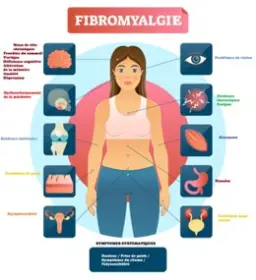Fibromyalgia and aromatherapy: a natural alliance to relieve symptoms
Fibromyalgia affects approximately 2 to 4% of the global population, predominantly women between the ages of 30 and 60. It is a complex and poorly understood chronic condition characterized by widespread pain, constant fatigue, sleep disturbances, and sometimes cognitive impairment. While conventional medical treatments are often limited to symptom management, complementary approaches such as aromatherapy are gaining recognition for their potential effectiveness and low side effects when used properly. This article explores how essential oils can be incorporated into a holistic care routine for people with fibromyalgia.
Fibromyalgia: what are the causes?
The origins of fibromyalgia remain uncertain to this day. No identifiable lesion or measurable biological abnormality has yet been associated with this condition. This does not mean, however, that they do not exist, but rather that current methods are not yet capable of detecting them. The lack of clear signs, the diversity of symptoms, and the complexity of diagnosis have long hampered the recognition of this disease.
It wasn't until 1992 that the World Health Organization (WHO) officially recognized it. Medical imaging, such as MRI, subsequently confirmed the existence of very real pain. Formerly classified as a psychosomatic disorder, fibromyalgia is now defined as a form of chronic generalized pain in the International Classification of Diseases.
Among the avenues being explored, a disruption of the pain processing system, involving the central and peripheral nervous systems, is being considered. Alterations in nerve cells could play a role. Other factors are also suspected, such as physical or emotional trauma, poorly managed stress, sleep disorders, or even certain viral infections. In the absence of a single identified cause, this multiplicity makes diagnosis and treatment particularly complex.
Aromatherapy: effectiveness and mechanisms of action
What is aromatherapy?
Aromatherapy is a branch of phytotherapy that uses volatile compounds extracted from plants, called essential oils (EO), for therapeutic purposes. These extracts are used for their biochemical properties (analgesic, anti-inflammatory, anxiolytic, etc.) and work both through inhalation and through the skin.
The use of essential oils is based on a detailed knowledge of their molecular composition and their effects, validated by studies in biochemistry, pharmacology and neuroscience (Franchomme & Pénoël, 2001).
Fibromyalgie : quels symptômes l’aromathérapie peut-elle cibler ?
Les huiles essentielles peuvent accompagner les traitements médicaux pour soulager :
· Muscle and joint pain
· Chronic fatigue
· Anxiety and mild depression
· Sleep disorders
· Headaches
· Digestive disorders associated with stress
https://inphysio.fr/blogs/news/fibromyalgie-traitements
The beneficial effects of certain essential oils have been validated by scientific studies, notably via :
- their action on the central nervous system (relief from anxiety, better quality of sleep),
- their anti-inflammatory and local analgesic properties,
- olfactory inhalation, which acts directly on the limbic system (emotional brain).
What symptoms to target with aromatherapy
1.Muscle and joint pain
One of the main symptoms of fibromyalgia is chronic pain.
Muscle pain relief synergy:
- Wintergreen (Gaultheria procumbens) – 10 drops
- Lemon Eucalyptus (Eucalyptus citriodora) – 8 drops
- True lavender (Lavandula angustifolia) – 5 drops
- Peppermint (Mentha piperita) – 2 drops
💧Dilute in 30 ml of vegetable oil (arnica or hazelnut). Apply locally to painful areas twice a day.
2. Chronic fatigue and exhaustion
Fatigue is often profound and persistent in people with fibromyalgia.
Revitalizing synergy (morning):
- Ravintsara (Cinnamomum camphora CT cineole) – 10 drops
- Black spruce (Picea mariana) – 5 drops
- Lemon zest (Citrus limon) – 8 drops
💧 Use 3 drops diluted in a vegetable oil and massage the adrenals (lower back) in the morning, or diffuse for 20 minutes.
3. Anxiety, stress and mood disorders
Chronic stress exacerbates pain and interferes with sleep.
Soothing synergy:
- True lavender (Lavandula angustifolia) – 10 drops
- Marjoram (Origanum majorana) – 8 drops
- Petitgrain bigarade (Citrus aurantium ssp. amara) – 6 drops
💧Diffuse for 15 to 20 minutes in the evening or apply 2 drops to the solar plexus or the arch of the foot, diluted in a mild vegetable oil (almond, apricot kernel).
4. Sleep disorders
One of the most disabling symptoms is unrefreshing sleep.
Deep sleep synergy:
- Roman chamomile (Chamaemelum nobile) – 5 drops
- True lavender – 10 drops
- Ho wood (Cinnamomum camphora CT linalool) – 5 drops
💧 Diffuse before bedtime or add 10 drops to a warm bath, mixed with a dispersant (bath salt, shower gel, etc.) or applied topically to the arch of the foot.
A non-exhaustive summary table of recommended essential oils
|
1. True Lavender |
Main virtues |
Symptoms relieved |
Why effective? |
|
1. True Lavender |
Calming, analgesic, muscle relaxant, sedative |
Insomnia, muscle pain, anxiety |
Soothes the nervous system, promotes restful sleep, relaxes muscles. |
|
2. Wintergreen |
Very powerful analgesic, anti-inflammatory |
Joint and muscle pain |
Rich in methyl salicylate, powerful aspirin-like pain-relieving effect. |
|
3. Lemon eucalyptus |
Anti-inflammatory, antispasmodic, calming |
Stiffness, muscle pain |
Reduces inflammation and relaxes sore muscles. |
|
4. Shell Marjoram |
Nerve sedative, antispasmodic |
Anxiety, diffuse pain, sleep disorders |
Soothes the nervous system and muscle tension. |
|
5. Roman Chamomile |
Sedative, calming, analgesic |
Stress, hypersensitivity, pain |
Reduces nerve reactivity and pain. |
|
6. Peppermint |
Analgesic, vasoconstrictor, refreshing |
Fatigue, headaches, localized pain |
Cools and numbs pain locally. |
|
7. Frankincense (Olibanum) |
Anti-inflammatory, relaxing, nervous balancing |
Diffuse pain, anxiety, nervous fatigue |
Promotes grounding and relieves chronic pain. |
|
8. Exotic basil |
Antispasmodic, relaxant, nerve tonic |
Spasms, abdominal pain, mental fatigue |
Relaxes smooth muscles and gently stimulates. |
|
9. Italian helichrysum |
Anti-hematoma, anti-inflammatory, circulatory |
Pain, micro-trauma, congestion |
Promotes the resorption of tissue tensions and micro-lesions. |
|
10. Ylang-Ylang |
Hypotensive, calming, harmonizing |
Anxiety, palpitations, mood disorders |
Soothes the heart and mind, balances emotions. |
|
11Petit grain bigarade |
Relaxing, antidepressant, antispasmodic |
Anxiety, irritability, nerve pain |
Helps release mental and physical tension. |
|
12. Sweet orange |
Calming, antidepressant, sedative |
Anxiety, disturbed sleep, fatigue |
Pleasant fragrance, gently acts on anxiety and mental fatigue. |
|
13. Ravintsara |
Immunostimulant, antiviral, nerve tonic |
Chronic fatigue, weak immune system |
Restores energy without exciting, supports weakened immunity. |
|
14. Niaouli |
Anti-infectious, circulatory stimulant |
Stiffness, joint pain |
Stimulates circulation and improves the elimination of toxins. |
|
15. Lemon |
Liver tonic, lymphotonic, refreshing |
Fatigue, slow digestion, heavy legs |
Drains the liver and toxins, reduces fatigue linked to overload. |
|
16. Cloves |
Powerful analgesic, anti-infectious |
Severe pain, dental or muscle pain |
Rich in eugenol, a powerful natural pain reliever. |
|
17. Camphor Rosemary |
Muscle relaxant, tonic, circulatory |
Muscle stiffness, fatigue |
Very useful in cases of deep muscle tension. |
|
18. Ginger |
Warming, analgesic, general tonic |
Joint pain, body cold |
Brings warmth to cold and painful areas. |
|
19. Palmarosa |
Regenerating, relaxing, balancing |
Stress, emotional fatigue |
Acts gently on mental and emotional fatigue. |
|
20. Rosewood |
Nerve rebalancing, tonic, antidepressant |
Anxiety, hypersensitivity, low morale |
Very gentle, but effective for emotional and nervous rebalancing. |
Safety tips and best practices
- • Use only chemotyped, 100% pure and natural essential oils,
- • Respect the dosages and never swallow without medical advice.
- • Do a patch test before any first use.
- • Avoid in pregnant women, breastfeeding women, children under 6 years of age, people with epilepsy, and in people with a history of hormone-dependent cancer
Conclusion
While not a substitute for medical treatment, aromatherapy offers a valuable complementary approach to relieving fibromyalgia symptoms. With well-chosen and well-used essential oils, it can reduce pain, improve sleep, soothe anxiety, and restore energy. It also finds its place in an integrative approach, associated with practices such as gentle physical exercise, sophrology, meditation or anti-inflammatory diet.
- All essential oils are available on the website. For any requests for synergies or other essential, vegetable, or hydrosol oils, do not hesitate to contact us: lateliermarcati@outlook.com or by phone: +32 470 33 53 63 lateliermarcati@outlook.com ou par téléphone: +32 470 33 53 63
*The information written in this article by the MARCATI Workshop comes in particular from references from the scientific literature. It is transmitted and shared for information purposes only. They therefore do not claim to be a substitute for medical advice, diagnosis or any treatment.
Bibliography (references in APA format)
Baudoux, D. (2020). Aromatherapy - Healing with Essential Oils (4th ed.). Editions Amyris.
Bercion, L. (2020). Fibromyalgia: Breaking free from pain. Paris: Éditions Josette Lyon.
Dextreit, R., & Béliveau, J. (2008). Fibromyalgia: Understanding and relieving. Montreal: Éditions de l'Homme.
Franchomme, P., & Pénoël, D. (2001). Aromatherapy exactly (2nd ed.). Roger Jollois.
Valnet, J. (1992). Aromatherapy: Treatment of Diseases by Plant Essences (8th ed.). Maloine.
Perrot, S. (2012). Understanding fibromyalgia. Paris: Odile Jacob.
Pousset, J. L. (2012). Phytotherapy and aromatherapy: Plant medicines. Paris: Éditions Médicis.
Share




Fibromyalgia in aromatherapy